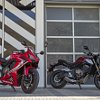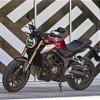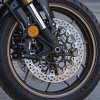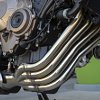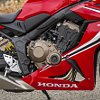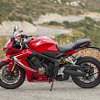When the invite came in for the press launch of Honda's CB650R and CBR650R, I had some real interest in attending. On paper, the Honda 650s look like some of the most underrated buys out there and I really wanted to find out for myself.
Put it this way: What are your typical rides really like? For most people shopping 650-class middleweights, you probably do short trips during the week, maybe some commuting. On weekends, you might take a quick tour, hit the fun roads with friends, or possibly get to a track day. Maybe a longer trip here or there. A naked or sporty 650 will do all that and more.

The class is already loaded with popular options like Yamaha’s MT-07 ($7,599), Suzuki’s SV650 ($7,099/$7,499 ABS), the Kawasaki Z650 ($6,999/$7,399 ABS), and the Triumph Street Triple S ($9,950). The Yamaha XSR700 ($8,499) and Suzuki SV650X ($8,399) are also in the running. For a faired 650, Kawasaki has you covered with their Ninja 650 ($7,399/$7,999 ABS). This is one of the most hyper-competitive markets in motorcycling.
Introduced in 2014, Honda’s CB650F/CBR650F models never quite fit in. Part of the problem might have been styling — not that the competition’s all that breathtaking. On top of that, Honda’s F series set itself apart by using a four-cylinder engine instead of a twin. For as much as I love them, inline fours typically weigh more than their twin counterparts and cost more to produce, all else being equal. As a result, the F models took a significant weight penalty while costing a fair bit more than their rivals.
If you’re Honda, what do you do? On one hand, you could get in line and follow everyone else. Or, take a much more interesting approach: overhaul the four-cylinder to offer something unique in this class.

Platform-wide improvements
I’ll start with changes shared between the models, then get into the individual models later.
Honda’s refinements of the 650 platform didn’t involve breaking the CB and CBR out into totally separate bikes, and I have no problem with that. It keeps the prices lower, and the shared components work well together, so why mess with the recipe?

The bikes have lighter, stiffer frames, and their riding positions are more aggressive than the previous versions. A significant upgrade is the front suspension. Honda ditched the F series’ conventional front end for a 41 mm Showa Separate Function Fork (SFF). The new fork offers radial caliper mounts for better braking. Honda’s fitted four-piston Nissin calipers for a respectably modern brake setup.Two-channel ABS and switchable traction control are available as an option. At the rear, Showa also supplies the seven-step adjustable rear shock.

Honda’s committed to this four-cylinder engine, so they spent some time improving its newest iteration. Changes to timing, piston shape, compression ratio, and intake design resulted in a 1,000 rpm bump for the redline. Peak torque is at 8,500 rpm, and peak horsepower’s at 12,000, so this engine wants to be revved. If you’re like me, that’s part of the appeal of these things in the first place. I’m glad to see Honda embrace the 650’s character. Honda doesn’t publish horsepower figures in the United States, but the general consensus guess among the test riders was about 80 and change. (Honda Europe claims 70 kW, or about 93 horsepower. This is right at the limit of some licensing restrictions in other countries.)

I’m glad to see that they kept one of my favorite parts of the powerplant, the four “waterfall” headers inspired by the old CB400F. I think these are some of the best-looking pipes on the market today. The muffler’s not quite so beautiful, especially from the bike’s left side where the muffling “box” is visible. Hey, manufacturers have to do what they can to pass modern noise emission standards. Just don’t give up those pipes!
These motorcycles share almost everything, so how different are they to ride? Honda made sure we could swap from one model to another as we tested the bikes around southern California.

The Honda CBR650R
I started on the CBR650R ($9,399/$9,699 ABS) for our first ride, and the bike got right to work making a good impression with me. The riding position is, as expected, a sporty lean forward that doesn’t fold the rider into unsustainable shapes. The clip-on bars have a slight rise to keep things reasonable. Seat height for both models is 31.9 inches, and with my 32-inch inseam, I could easily get both feet flat on the ground.

As we set off, I found a very light clutch pull. Honda told me they gave the new 650s a hydraulic assist to the cable-actuated clutch, making the lever easier to pull. And with the linear power delivery, repeated stops and starts with traffic are painless. Shifting through the six-speed was no problem around town as we made for the highway. The throttle is mechanical — no ride-by-wire here — which means no rider modes. Somebody will complain, but the smooth, predictable power really doesn't need modes. Use your wrist! Already I was winding the thing out just to hear the engine do its thing. For street use, the 650 makes all the right sounds at all the right speeds. There's even a programmable shift light to play with.
The CBR jammed along just fine at freeway pace, totally stable. I’d much rather commute or road-trip with one of these than a track-oriented supersport! The engine wasn’t as stressed or buzzy as a twin, either. At any time, I could roll on more power, and the CBR would deliver without complaint. This 650-four business makes a lot of sense for everyday riding.

Plenty of riders love the way a sport bike looks. Not everyone needs the bleeding-edge performance. That’s where the redesigned CBR can step in with its blend of streetable ergos, fun engine, and racy looks. For the sport bike fans, the bike’s entire front design is lifted straight off the CBR1000RR. Even the ram air ducts actually work. The CBR might be the most approachable way to get onto a new inline-four with aggressive styling. Or, if you loved the CBR600F2s and F3s of the 1990s, this is about the closest thing you’ll find to them in a showroom today.
Time to swap to the CB and see what that’s about.

The Honda CB650R
As I hopped on the CB650R ($8,899/$9,199 ABS), the standard handlebar and altered footpeg position sat me more straight up, in contrast to my forward cant on the CBR. There's no doubt this is a standard. I immediately liked the way the front of the bike drops away just beyond the redesigned LCD cluster. It makes the CB feel compact, even though it shares the same rake, trail, and wheelbase specs with the CBR. Wider, taller bars help the rider throw the machine through corners in a completely different style from the CBR. Great fun.

Of course, the engine feels just like the CBR’s while riding. Your neighbors will appreciate how quiet it is at low speed, though the bike constantly hopes you’ll wind it up. The engine revs quickly (for a non-supersport) and power is very predictable. No flat spots or wavering. Around 6,000 rpm comes a vibration from the engine. This is fine. The engine is asking, “What do you want to do here? We can grab another gear and cruise, or push up into the powerband.” Torque and horsepower are above 6,000, after all. I deeply enjoyed sending the needle up the tach without worrying about losing my license. Try that beyond second gear on a supersport!

Something about a middleweight naked with a four just works so well, I’m surprised the CB doesn’t have much competition. Back in the day, they called them UJMs, or “Universal Japanese Motorcycles.” Everyone made a standard middleweight with a transverse four. I’m struggling to think of anything currently available that could compare. (Maybe the Suzuki GSX-S750?) Best of all, Honda’s gone for a total redesign with their “Neo Sports Cafe” styling.

I think the CB650R is awfully photogenic. It’s modern, funky, and different from just about everything out there. The distinctive round headlight is the star of the show, giving a nod to classic UJMs while packing very modern LEDs. Bronze wheels give a unique look too, painted to match the engine covers. Honda even anodized the fork tubes on the new 650s to match that bronze. It’s a little touch that makes the whole bike look more cohesive, even more premium. (Anodized parts mismatched to paint can drive me nuts!)

For the ride through the Santa Rosa and San Jacinto Mountains National Monument towards Temecula, I swapped back to the CBR to see how far its sporting aspirations could take it. We soon hit some curves where I could start leaning the thing around. Those suspension improvements paid off big time, with very good feel and feedback all around. The front fork doesn’t excessively dive or pogo. It just feels planted. If this is how they’re shipping them, this 170-pound rider doesn’t really mind the lack of adjustability. Brakes and throttle both responded well to small adjustments. (I didn't have an opportunity to use the ABS or traction control. Probably a good thing.) The whole package works exactly as it should, with enough power that it's a rewarding experience. These CBRs don't want to throw you off or race everything on the road. They just wanna ride.

Ditto for the CB, which I switched back to for our return through the mountains. There's only so much you can compare between these models since they have so much in common. I found myself preferring the CB's less serious nature by the end of the day. It suits the friendly engine. Leaning into corners feels a bit more exciting due to the riding position, and the CB feels like the better all-rounder. Blasting around on a naked that sounds like a sport bike has a real appeal, too.

So, which one should I buy?
An unavoidable question. I bet you had a favorite picked out halfway through the article, or maybe even before you started reading. These motorcycles are so similar that I don't think it matters beyond your own personal preferences about the style. But potential buyers should try both. For longer trips or occasional track days, I'd go CBR. For more urban riding, you'll want the CB. Neither will be far behind the other in any regard, since they're mechanically so similar anyway.
Are these the underrated, rational street machines I'd hoped to find? Actually... yeah, they are. These motorcycles are highly competent, not to mention fairly unique within their space. Updates, internal and external, have taken them far enough from the first 650s that the model name change from F to R is justified. All that comes at a price, but so would buying their cheaper competitors and modifying them to perform at the same level. And that's without the aesthetic updates that make the Hondas feel so much more refined.
There will always be riders who take a hard pass on these bikes. Supersports are faster. Budget 650 twins are cheaper. Honda's not looking to draw those buyers in with the CBR650R or the CB650R. These motorcycles are for riders who've added up their wants and needs, only to find a very real-world answer. I'm just not sure that these bikes will stay underrated once the word gets out.
| 2019 Honda CB650R and CBR650R | |
|---|---|
| Price (MSRP) |
CB650R: $8,899/$9,199 ABS CBR650R: $9,399/$9,699 ABS |
| Engine type | Four-stroke, liquid-cooled, DOHC four cylinder |
| Displacement | 649 cc |
| Bore/stroke | 67 mm / 46 mm |
| Compression ratio | 11.6:1 |
| Transmission | six gears |
| Fuel system | PGM-FI (throttle body 32 mm) |
| Clutch | Multiplate wet |
| Front Suspension | 41 mm Showa SFF inverted fork |
| Rear suspension | Showa single shock, adjustable preload |
| Suspension travel front/rear | 108/128 mm (4.25/5.04 inches) |
| Tires front/rear | 120/70-17; 180/55-17 |
| Trail | 101 mm / 4.0 inches |
| Steering head angle | 30.0 degrees |
| Wheelbase | 1,447.8 mm / 57 inches |
| Ground clearance |
CB650R: 147.2 mm / 5.8 inches CBR650R: 132.1 mm / 5.2 inches |
| Length | 2,131.1 mm / 83.9 inches |
| Seat height | 810.3 mm / 31.9 inches |
| Tank capacity | 15.5 liters / 4.1 gallons |
| Front brake | Dual Nissin four-piston, radially mounted calipers, 310 mm discs |
| Rear brake | Single 240 mm disc |
| Weight (ready to ride) |
CB650R: 445 pounds / 447 pounds (ABS) CBR650R: 456 pounds / 458 pounds (ABS) |





